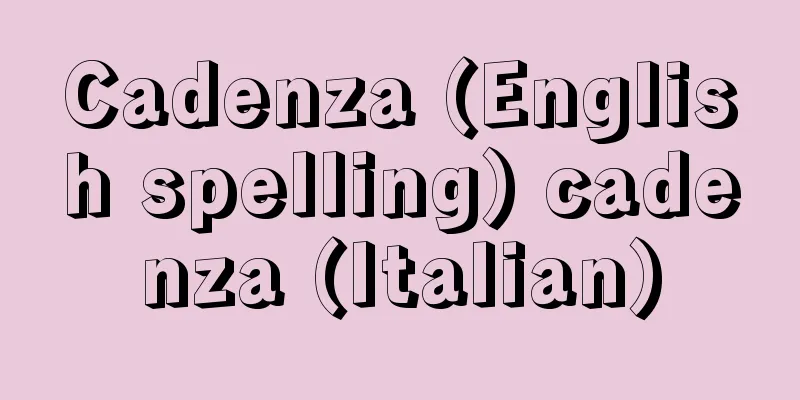Cadenza (English spelling) cadenza (Italian)

|
Musical term. (1) Harmonic cadence. There are three types of harmonic cadence: perfect cadence, imperfect cadence, and false cadence. Perfect cadence refers to the succession of a dominant chord and a tonic chord in the basic position, and strictly speaking, this is limited to cases where the upper voice is on a strong beat and takes the tonic note. It can also include the succession of a subdominant chord and a tonic chord in the basic position. It is used at the end of a piece of music or to close each section, giving a satisfactory closure. Imperfect cadence refers to the succession of a dominant chord and a tonic chord, one of which is inverted, but in English usage it also includes half cadences. Half cadences usually refer to a progression from a tonic chord to a dominant chord, but can also include progressions from chords other than the tonic chord. Half cadences are placed at the break of a phrase, such as the previous section in a grand section structure, and have the ability to connect to the following section. A false cadence is a cadence that goes from a dominant chord to a chord other than the tonic chord, and a typical example is a progression to a 6th chord. It occurs in the middle of a phrase and acts as a slight pause, and rather than providing a sense of closure, it has the effect of disappointing the expectation of a cadence. (2) Cadenza fioritura or cadenza di bravura. An ornamental phrase inserted before the coda (the conclusion of a piece) to demonstrate the virtuoso technique of the soloist or singer. Originally, it was an improvisation by the performer, but from around Beethoven's Piano Concerto No. 5 ("Emperor"), it began to be written by the composer. [Toshiaki Kurosaka] ©Shogakukan "> Cadenza (harmonic cadence) Source: Shogakukan Encyclopedia Nipponica About Encyclopedia Nipponica Information | Legend |
|
音楽用語。 (1)和声終止形のこと。和声終止形には、大別して、完全終止、不完全終止、偽(ぎ)終止の3種類がある。完全終止とは、基本位置での属和音と主和音の連続をさし、厳密には上声部が強拍で、主音をとる場合に限られる。また、基本位置での下属和音と主和音の連続も含むことができる。楽曲の終わりや各部分を閉じる箇所に用いられ、満足な完結性を与える。不完全終止とは、どちらか一方が転回形の属和音と主和音の連続をさすが、英語の慣用では半終止もこれに含める。半終止とは、通常、主和音から属和音への進行をさすが、主和音以外の和音からの進行も含まれる。半終止は、大楽節構造における前楽節のようなフレーズの切れ目に置かれ、後続部分への連結性をもっている。偽終止とは、属和音から主和音以外の和音へ行く終止で、Ⅵ度の和音への進行が代表的である。フレーズの途中にあって軽いくぎりとなり、終止感というよりは、むしろ終止の期待を裏切る効果をもっている。 (2)カデンツァ・フィオリトゥーラcadenza fiorituraやカデンツァ・ディ・ブラブーラcadenza di bravuraの略。独奏者や独唱者の名人芸的技巧を示すべく、コーダ(楽曲終結部)の前に挿入された装飾的楽句をさす。元来、演奏者の即興演奏であったが、ベートーベン作曲のピアノ協奏曲第5番(「皇帝」)あたりから、作曲者によって書かれるようになった。 [黒坂俊昭] ©Shogakukan"> カデンツァ(和声終止形) 出典 小学館 日本大百科全書(ニッポニカ)日本大百科全書(ニッポニカ)について 情報 | 凡例 |
Recommend
Anji - Anji
...The conclusion of Quatrephages and others was ...
Meimuna opalifera
An insect of the Hemiptera family, Cicadaidae (ill...
facultative organism
…Among heterotrophic organisms, there are aerobic...
Ilya - Ilya
...These figures and spirits from the old tales a...
Thomsen
[1] (Christian Jürgensen Thomsen) Danish archaeolo...
Azuki bean weevil - Azuki bean weevil
...An insect of the beetle order Bruchidae family...
Fukuoka [Prefecture] - Fukuoka
A prefecture in the northern part of Kyushu. It fa...
Cadmos - Kadmos (English spelling)
In Greek mythology, he was the founder and first ...
Zhang Fei
A military commander in the Three Kingdoms state ...
Buceros
…Hornbills live in a variety of wooded environmen...
Douglas, JS (English spelling) DouglasJS
… The repeated bans caused a sense of crisis for ...
Motorboat Racing
(1) A speed race between two or more motorboats. B...
brannerite
...There are many mineral species that contain ur...
Theory of stellar evolution
The idea that stars evolve has been around since t...
Nakagawa [town] - Nakagawa
A former town in Naka District, eastern Tokushima ...









